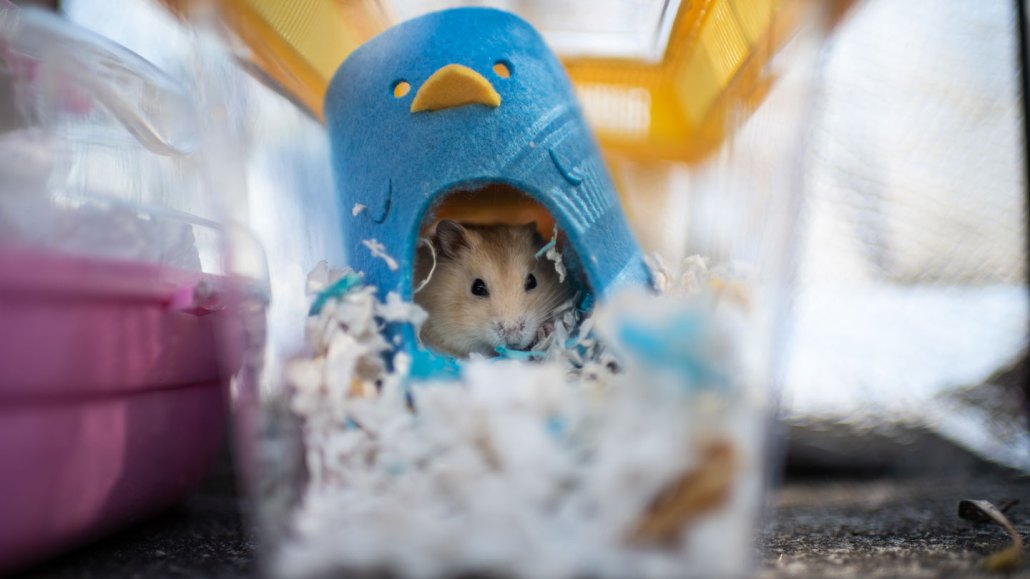
In January, Hong Kong culled hamsters for sale or recently purchased from pet shops after a cluster of human cases cropped up around a shop where the rodents tested positive for the coronavirus that causes COVID-19. This hamster escaped the cull thanks to volunteers who adopted it.
Louise Delmotte/Getty Images News
- More than 2 years ago
Golden Syrian hamsters are highly susceptible to the coronavirus that causes COVID-19, a new study shows.
While the species is popular among pet owners, the results, posted April 20 at bioRxiv, are not cause for panic, says Anne Balkema-Buschmann, a veterinarian at the Friedrich-Loeffler-Institut in Riems, Germany. “The message of this paper is not that hamsters are ticking time bombs that can’t be kept in households any longer.” But pinpointing just how sensitive the animals are to SARS-CoV-2 can help researchers fine-tune experiments that use hamsters to test potential treatments for COVID-19.
The rodents made headlines in January when a cluster of COVID-19 cases in people emerged around pet shops in Hong Kong. In accordance with its “zero-COVID” strategy, the government culled over 2,000 animals. A viral genetic analysis ultimately revealed that infected hamsters had transmitted the delta variant of the virus to humans twice, leading to at least one further human-to-human transmission. Aside from an instance of mink-to-human transmission in Denmark and a possible case of white-tailed deer-to-human transmission in Canada, this is the only documented example of the virus going from animals to humans.
Hamsters can transmit the virus to their uninfected brethren and display similar pneumonia symptoms to humans. So since the early days of the pandemic, the rodents, including Golden Syrians (Mesocricetus auratus), emerged as a useful animal model for COVID-19 drug and vaccine research.
To better design their own COVID-19 vaccine and drug studies, Balkema-Buschmann’s team tried to determine how much SARS-CoV-2 virus actually makes the animals sick and shed the virus. The researchers found that the minimum infectious dose for hamsters is 1/5000th of some previous estimates and 1/100,000th the minimum infectious dose for humans.
With this minimum dose, the virus infected the animals’ lungs and replicated in the nose and throat. When that minimum dose was increased by a factor of 100, rapid tests of oral swabs from the animals turned up positive results, and the animals got pneumonia and lost weight. There was also a few day delay before the animals started shedding virus and exhibiting disease symptoms, which might cause hamster cases to go unnoticed. Other hamster species that can pick up the virus may have similar risk, and even at low doses, the animals may shed enough virus to infect humans.
For researchers, the results provide a better timeline of disease progression in hamsters and may mean lowering hamster virus dosage levels in drug and vaccine studies to better mirror what happens in humans. For pet owners, the takeaway is to use proper hygiene around hamsters if a human in the household tests positive for the virus and to consult a veterinarian. Swabbing your pet hamster’s mouth could also tell you if it might be infected.
“We don’t think from these results that hamsters play a role in the dynamics of pandemic. It’s just that the virus might ping-pong within the household if an infected person has close contact with a hamster,” says Balkema-Buschmann.
The greater danger, says Leo Poon, a virologist at the University of Hong Kong who studied the pet shop cluster, is hamsters in farmed or pet trade settings. “With such a high susceptibility to SARS-CoV-2, an introduction of an infectious hamster to a hamster farm or a batch of hamsters might cause an outbreak in the population,” says Poon. “Even worse, it might be silently spreading.”
The new hamster study also examined two genetic versions of the virus from hamsters that received high and low doses, respectively. Neither contained significant mutations. Whenever a virus passes between species there’s a concern that it might mutate and become more infectious or dangerous (as we’ve seen in humans), but Poon notes that one would need to see multiple rounds of infection to say anything about the mutation risk in these rodents.
Sign up for our newsletter
We summarize the week's scientific breakthroughs every Thursday.





